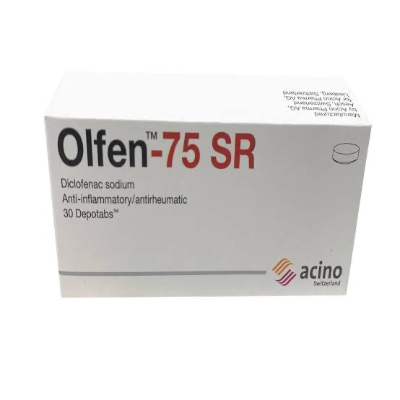


Migraine (attack)
Pain and/or inflammation
Treatment of post-operative pain
Fever in ear, nose or throat infection
75mg to 150mg a day, in two or three divided doses.
Children under 9 years
Cerebrovascular disorder
Gastrointestinal haemorrhage
Gastrointestinal perforation
Gastrointestinal ulcer
History of gastrointestinal haemorrhage
History of peptic ulcer
Ischaemic heart disease
New York Heart Association class II failure
Peripheral arterial circulatory disorder
Renal impairment - glomerular filtration rate below 10ml/minute
Severe hepatic impairment
Third trimester of pregnancy
Allergic disposition
Elderly
Females attempting to conceive
Risk factors for cardiovascular disorder
Asthma
Breastfeeding
Connective tissue disorder
Crohn's disease
First trimester of pregnancy
Glucose-galactose malabsorption syndrome
Haematological disorder
Hepatic impairment
Hereditary fructose intolerance
Hypertension
New York Heart Association class I failure
Renal impairment - glomerular filtration rate 10-20ml/minute
Second trimester of pregnancy
Systemic lupus erythematosus
Ulcerative colitis
May mask symptoms or signs of infections
May precipitate bronchospasm in patients with asthma or allergy
Advise patient dizziness may affect ability to drive or operate machinery
Not all available brands are licensed for all age groups
Not all available brands are licensed for all indications
Some formulations contain sucrose
Some products may contain soya or soya derivative
Discontinue if signs of gastro-intestinal bleeding occur
May inhibit platelet aggregation - observe for signs of bleeding
Monitor hepatic function on long term therapy
Monitor renal function in patients with hepatic impairment
Monitor renal function on long term therapy
Perform blood counts on prolonged use of this treatment
Advise patient to inform their physician if dyspnoea/chest pain occur
Advise patient to report gastrointestinal signs or symptoms
High dose/long term use may increase risk of arterial thrombotic events
Severe gastro-intestinal side effects may occur without warning
Discontinue treatment if rash occurs
Dose varies with brand
Maintain treatment at the lowest effective dose
Elderly patients have increased frequency of adverse reactions, especially gastrointestinal bleeding and perforation which may be fatal. These patients should commence treatment on the lowest dose available and be monitored for gastrointestinal bleeding for 4 weeks following initiation of therapy.
Patients with renal or hepatic impairment and the elderly should be kept under surveillance, since the use of NSAIDs may result in deterioration of renal function. The lowest effective dose should be used and renal function monitored.
If abnormal liver function tests persist or worsen, clinical signs or symptoms consistent with liver disease develop, or if other manifestations occur (eosinophilia, rash, etc) treatment should be discontinued. Hepatitis may occur without prodromal symptoms.
Diclofenac potassium may reversibly inhibit platelet aggregation. Patients with defects of haemostasis, bleeding diathesis or haematological abnormalities should be carefully monitored.
Diclofenac potassium is contraindicated during the third trimester of pregnancy but may be used with caution during the first and second trimester.
The manufacturer does not recommend this product during pregnancy.
First trimester exposure to NSAIDs has been associated with an increased risk spontaneous abortions and of birth defects (notably cardiac septal defects). There is conflicting evidence, however, from various studies and the risk appears to be low.
When an NSAID is considered essential, a more established drug such as ibuprofen may be considered. Diclofenac should be used with caution in the first and second trimesters. Schaefer (2007) considers that use of NSAIDs in early pregnancy does not require termination of pregnancy or invasive diagnostic procedures.
Diclofenac is a prostaglandin synthetase inhibitor and may have the following effects during the second and third trimesters:
- Pulmonary and cardiac toxicity in the foetus/newborn (pulmonary hypertension with preterm closing of the ductus arteriosus). The risk exists from the beginning of the sixth month and increases if administration is close to full term.
- Functional renal injury in the foetus. From the twelfth week: oligohydramnios (usually reversible after the end of treatment) or anamnios (particularly with prolonged exposure). Following birth, renal failure may persist (especially with late and prolonged exposure).
- Inhibition of uterine contractions with delayed onset and prolongation of labour.
- Increased possibility of bleeding in mother and child.
- Increased risk of maternal oedema formation.
- When used in the peri-natal period, necrotising enterocolitis and intraventricular haemorrhages have been reported in very pre-term and very low birth weight infants.
Use diclofenac potassium with caution during breastfeeding.
The manufacturer does not recommend breastfeeding whilst taking diclofenac potassium.
In limited studies so far available, NSAIDs can appear in breast milk in very low concentrations.
When an NSAID is considered necessary during breastfeeding ibuprofen or flurbiprofen would be the drugs of choice although occasional use of diclofenac is permissible.
The secretion in maternal milk following oral administration is minimal and probably too low to affect the infant. Diclofenac has a short half-life of 1.1 hours and a number of active metabolites although the clinical significance of these is not known.
Abdominal pain
Abnormal liver function
Acute renal insufficiency
Aggravation of existing asthma
Agranulocytosis
Anaphylactoid reaction
Anaphylaxis
Anorexia
Anxiety
Aphthous stomatitis
Aplastic anaemia
Arterial thrombosis
Aseptic meningitis
Asthma
Bronchospasm
Cerebrovascular accident
Chest pain
Colonic stricture
Confusion
Congestive cardiac failure
Constipation
Convulsions
Depression
Diarrhoea
Diarrhoea - bloody
Disorientation
Disturbances of sensation
Dizziness
Drowsiness
Dyspepsia
Dyspnoea
Eczema
Exacerbation of colitis or Crohn's proctocolitis
Fatigue
Flatulence
Gastritis
Gastro-intestinal perforation
Gastro-intestinal ulceration
Gastrointestinal bleeding
Glossitis
Haematemesis
Haematuria
Haemolytic anaemia
Hair loss
Hallucinations
Headache
Hearing disturbances
Hepatic failure
Hepatic impairment
Hepatic necrosis
Hepatitis
Hypersensitivity reactions
Hypertension
Hypotension
Impotence
Increases in hepatic enzymes
Insomnia
Interstitial nephritis
Irritability
Ischaemic colitis
Jaundice
Kounis syndrome
Leucopenia
Lyell's syndrome
Malaise
Melaena
Memory disturbances
Myocardial infarction
Nausea
Nephrotic syndrome
Neutropenia
Nightmares
Non-specific allergic reactions
Non-specific haemorrhagic colitis
Oedema
Oesophageal lesions
Palpitations
Pancreatitis
Papillary necrosis
Paraesthesia
Photosensitivity
Pneumonitis
Proteinuria
Pruritus
Psychotic symptoms
Purpura
Renal failure
Shock
Skin disorder
Stevens-Johnson syndrome
Taste disturbances
Thrombocytopenia
Tinnitus
Tiredness
Tremor